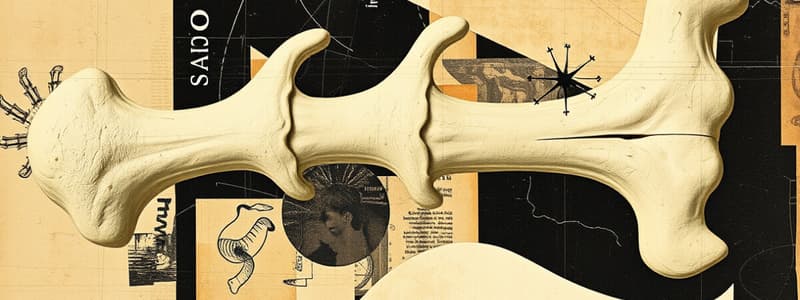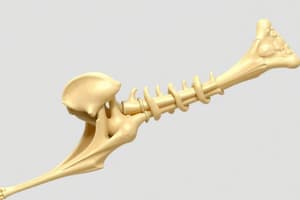Podcast
Questions and Answers
Intramembranous ossification produces the __________. (Select one)
Intramembranous ossification produces the __________. (Select one)
- Short bones of the ankle
- Short bones of the wrist
- Long bones of the limbs
- Flat bones of the skull (correct)
- Irregular bones of the vertebrae
In endochondral ossification, the precursor connective tissue is __________, which is replaced by bone. (Select one)
In endochondral ossification, the precursor connective tissue is __________, which is replaced by bone. (Select one)
- Transitional epithelium
- Fibrocartilage
- Fibrous membranes
- Hyaline cartilage (correct)
- Embryonic mesenchyme
The __________ is a marginal zone of the epiphyseal plate where, in children and adolescents, bone can be seen replacing the hyaline cartilage. (Select one)
The __________ is a marginal zone of the epiphyseal plate where, in children and adolescents, bone can be seen replacing the hyaline cartilage. (Select one)
- Primary ossification center
- Metaphysis (correct)
- Epiphyseal line
- Secondary ossification center
- Osteoid tissue
Achondroplastic dwarfism is a hereditary condition, in which the long bones of the limbs fail to elongate normally because of reduced hyperplasia and hypertrophy of cartilage in the __________. (Select one)
Achondroplastic dwarfism is a hereditary condition, in which the long bones of the limbs fail to elongate normally because of reduced hyperplasia and hypertrophy of cartilage in the __________. (Select one)
Chondrocytes multiply in the zone of __________ of the metaphysis. (Select one)
Chondrocytes multiply in the zone of __________ of the metaphysis. (Select one)
Mature bones are remodeled throughout life via a process known as __________. (Select one)
Mature bones are remodeled throughout life via a process known as __________. (Select one)
Bone elongation is a result of __________. (Select one)
Bone elongation is a result of __________. (Select one)
Wolff's law of bone explains the effect of __________. (Select one)
Wolff's law of bone explains the effect of __________. (Select one)
A growing long bone in a child has only two areas of cartilage at the epiphysis. These two areas are the __________. (Select one)
A growing long bone in a child has only two areas of cartilage at the epiphysis. These two areas are the __________. (Select one)
The process of dissolving bone and returning its minerals to the bloodstream is known as __________. (Select one)
The process of dissolving bone and returning its minerals to the bloodstream is known as __________. (Select one)
Study Notes
Bone Development and Ossification Processes
- Intramembranous ossification creates flat bones, specifically forming the flat bones of the skull.
- Endochondral ossification involves the transformation of hyaline cartilage into bone, serving as a precursor connective tissue.
Key Zones in Bone Growth
- The metaphysis, found at the epiphyseal plate, is critical for bone replacement of hyaline cartilage during childhood and adolescence.
- Achondroplastic dwarfism results from inadequate growth of long bones due to reduced cartilage proliferation and hypertrophy at the epiphyseal plate.
Bone Cell Activities
- In the zone of cell proliferation within the metaphysis, chondrocytes actively multiply, facilitating growth.
- Mature bones continuously remodel through appositional growth, allowing for changes in shape and density over a person's lifespan.
Growth Mechanisms
- Bone elongation primarily occurs through cartilage growth, highlighting the importance of the epiphyseal plate in developing long bones.
- Wolff's law of bone states that mechanical stress influences bone remodeling, indicating that how bones are used affects their structure and density.
Cartilage and Ossification Centers
- In children, growing long bones feature two cartilage regions: the articular cartilage and the epiphyseal plate, critical for joint health and growth.
- Resorption is the process that involves dissolving bone tissue and releasing its minerals back into the bloodstream, essential for maintaining calcium levels in the body.
Studying That Suits You
Use AI to generate personalized quizzes and flashcards to suit your learning preferences.
Description
Explore the fascinating processes of bone development, focusing on intramembranous and endochondral ossification. Understand key growth zones such as the metaphysis and how they influence bone shape and density throughout life. This quiz will test your knowledge on bone cell activities and growth mechanisms.




